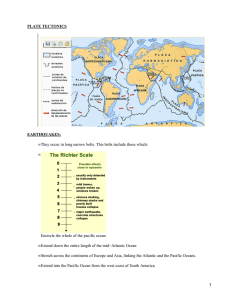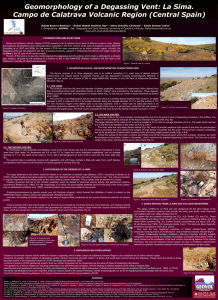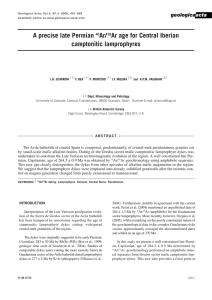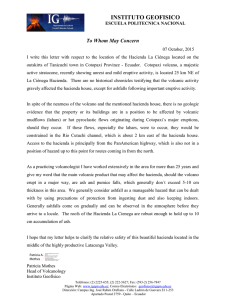New 40Ar/39Ar ages from the Central Part of the Chiapanecan
Anuncio
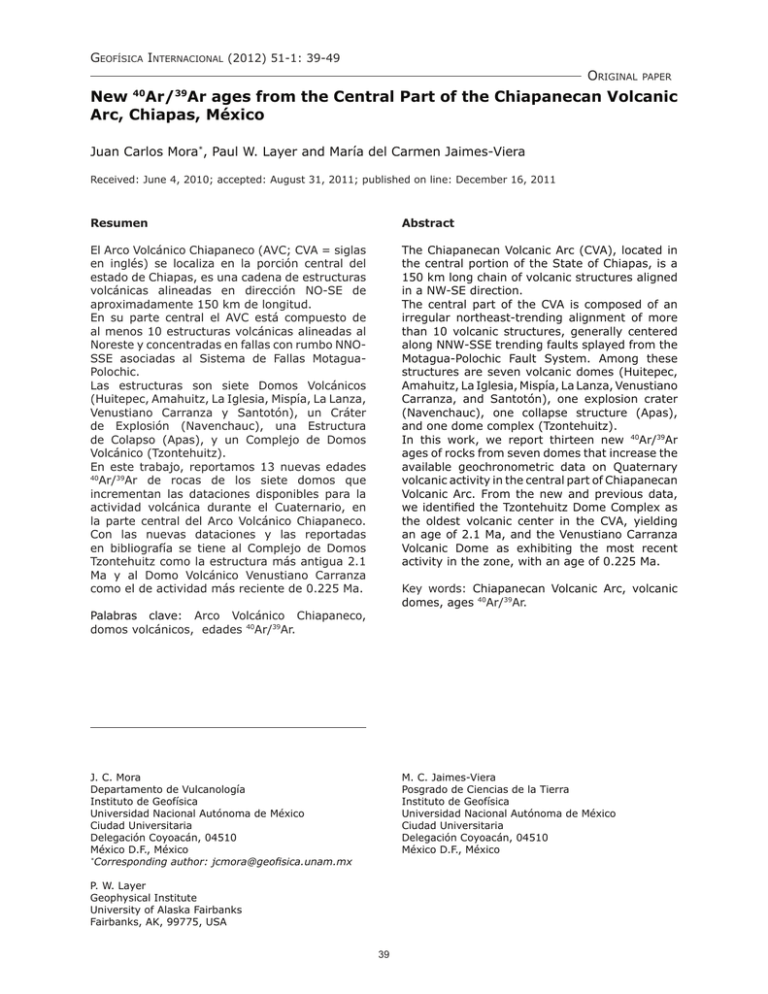
Geofísica Internacional (2012) 51-1: 39-49 Original paper New 40Ar/39Ar ages from the Central Part of the Chiapanecan Volcanic Arc, Chiapas, México Juan Carlos Mora*, Paul W. Layer and María del Carmen Jaimes-Viera Received: June 4, 2010; accepted: August 31, 2011; published on line: December 16, 2011 Resumen Abstract El Arco Volcánico Chiapaneco (AVC; CVA = siglas en inglés) se localiza en la porción central del estado de Chiapas, es una cadena de estructuras volcánicas alineadas en dirección NO-SE de aproximadamente 150 km de longitud. En su parte central el AVC está compuesto de al menos 10 estructuras volcánicas alineadas al Noreste y concentradas en fallas con rumbo NNOSSE asociadas al Sistema de Fallas MotaguaPolochic. Las estructuras son siete Domos Volcánicos (Huitepec, Amahuitz, La Iglesia, Mispía, La Lanza, Venustiano Carranza y Santotón), un Cráter de Explosión (Navenchauc), una Estructura de Colapso (Apas), y un Complejo de Domos Volcánico (Tzontehuitz). En este trabajo, reportamos 13 nuevas edades 40 Ar/39Ar de rocas de los siete domos que incrementan las dataciones disponibles para la actividad volcánica durante el Cuaternario, en la parte central del Arco Volcánico Chiapaneco. Con las nuevas dataciones y las reportadas en bibliografía se tiene al Complejo de Domos Tzontehuitz como la estructura más antigua 2.1 Ma y al Domo Volcánico Venustiano Carranza como el de actividad más reciente de 0.225 Ma. The Chiapanecan Volcanic Arc (CVA), located in the central portion of the State of Chiapas, is a 150 km long chain of volcanic structures aligned in a NW-SE direction. The central part of the CVA is composed of an irregular northeast-trending alignment of more than 10 volcanic structures, generally centered along NNW-SSE trending faults splayed from the Motagua-Polochic Fault System. Among these structures are seven volcanic domes (Huitepec, Amahuitz, La Iglesia, Mispía, La Lanza, Venustiano Carranza, and Santotón), one explosion crater (Navenchauc), one collapse structure (Apas), and one dome complex (Tzontehuitz). In this work, we report thirteen new 40Ar/39Ar ages of rocks from seven domes that increase the available geochronometric data on Quaternary volcanic activity in the central part of Chiapanecan Volcanic Arc. From the new and previous data, we identified the Tzontehuitz Dome Complex as the oldest volcanic center in the CVA, yielding an age of 2.1 Ma, and the Venustiano Carranza Volcanic Dome as exhibiting the most recent activity in the zone, with an age of 0.225 Ma. Key words: Chiapanecan Volcanic Arc, volcanic domes, ages 40Ar/39Ar. Palabras clave: Arco Volcánico Chiapaneco, domos volcánicos, edades 40Ar/39Ar. M. C. Jaimes-Viera Posgrado de Ciencias de la Tierra Instituto de Geofísica Universidad Nacional Autónoma de México Ciudad Universitaria Delegación Coyoacán, 04510 México D.F., México J. C. Mora Departamento de Vulcanología Instituto de Geofísica Universidad Nacional Autónoma de México Ciudad Universitaria Delegación Coyoacán, 04510 México D.F., México * Corresponding author: jcmora@geofisica.unam.mx P. W. Layer Geophysical Institute University of Alaska Fairbanks Fairbanks, AK, 99775, USA 39 J. C. Mora, P. W. Layer and M. C. Jaimes-Viera Introduction The Chiapanecan Volcanic Arc (CVA), located in the central portion of the State of Chiapas, is a 150 km long chain of volcanoes irregularly aligned in a northwestly direction between two more prominent volcanic features: the TransMexican Volcanic Belt (TMVB) to the northwest and the Central American Volcanic Arc (CAVA) to the southeast. While both the TMVB and the CAVA have been the focus of numerous geological and geochronological studies (Demant, 1976, 1978; Nixon, 1982; Siebe et al., 1995; Suter et al., 1995; Aguirre et al., 1998; Aguirre et al., 1998; Ferrari, et al., 1999; Wallace et al., 1999; Aguirre and Carranza, 2000), the CVA has been relatively unmapped and poorly described until recently (Jaimes-Viera et al. 2004; Jaimes-Viera, 2006; Mora et al., 2007). These authors have identified eight volcanic domes (Navenchauc, Huitepec, Amahuitz, La Iglesia, Mispía, La Lanza, Venustiano Carranza and Santotón), one explosion crater (Navenchauc), one collapse structure (Apas), and one dome complex (Tzontehuitz) within the CVA, and have documented changes in the eruptive style and chemical composition of the eruptive products of these volcanic centers. The CVA lies in a tectonically complex region where three tectonic plates interact: the North American Plate, the Caribbean Plate, and the Cocos Plate (Figure 1). A zone of lateral displacement and a zone of convergence define the boundaries between these plates. The first is characterized by a regional system of leftlateral strike-slip faults known as the MotaguaPolochic Fault System, formed by the eastward migration of the Caribbean Plate relative to the North American Plate, and the second is formed by the subduction of the Cocos plate under the North American and Caribbean Plates (Mora et al., 2007). Because of its geographic location, the CVA has a very important role in the geological evolution of the region. The purpose of this study is to demonstrate that the CVA volcanic activity is continuous from 2 Ma to the present and it is related to both the TMVB and CAVA. Geologic setting and previous work. The CVA was first described by Damon and Montesinos (1978) who named it “Modern Chiapanecan Volcanic Arc”. These authors described it as a 150 km- long volcanic structure aligned NW-SE. Damon and Montesinos (1978) concluded that the CVA was formed as a result of a readjustment of the direction of plate motion of the Cocos Plate at 2.79 Ma; they believed it to be essentially continuous with the TMVB. Capaul (1987) renamed this arc the “Chiapanecan Volcanic Arc” (CVA), and described it as composed of Quaternary volcanoes, including El Chichón volcano, characterized by low eruptive Figure 1. Location map and tectonic setting of the Chiapanecan Volcanic Arc (CVA), Trans-Mexican Volcanic Belt (TMVB) and Central American Volcanic Arc (CAVA). 40 Volume 51 Number 1 Geofísica Internacional volume and that were formed in a tectonically complex region of Chiapas. All eruptive products of the CVA have intermediate, calc-alkaline compositions except El Chichón which has some basic alkaline affinity (trachybasalts) (Capaul, 1987). Jaimes-Viera et al. (2004) conducted preliminary mapping of the central part of the CVA and showed 11 volcanic structures with deposits of pyroclastic flows and associated fall deposits (Figure 2; Damon and Montesinos, 1978; Capaul, 1987; Macias et al., 2003; JaimesViera, et al., 2004). The volcanic activity in the CVA was mainly effusive, accompanied by less frequent explosive and phreatomagmatic events and is characterized by volcanic domes accompanied by block-andash flows, ash flows with accretionary lapilli, falls, and pumice flows. The volcanic structures and deposits are calcalkaline in composition with a medium to high content of potassium. CVA volcanic rocks vary from basaltic andesite to dacite with SiO2 between 55 and 66 wt.% (Mora et al., 2007). Jaimes-Viera (2006) and Mora et al. (2007) divided the study area into three groups, according with their location. The first group is represented by the Tzontehuitz Dome Complex; located at the northern part. The second group is composed of the Apas, Navenchauc, Huitepec and Amahuitz volcanic structures; they were emplaced between 2 faults: Chicoasén-MalpasoHuixtlán to the north and Bajucú to the south. The last group consists of the Mispía, La Iglesia, Santotón and Venustiano Carranza domes. This group is characterized by a N-S alignment (Figure 2). Ar/39Ar geochronologic study 40 For 40Ar/39Ar analysis, we sampled lava domes and juvenile blocks from pyroclastic flow deposits of 9 of the 11 volcanic structures in the CVA. Thirteen crushed and sieved (to ~0.3 mm) whole- rock samples (pheoncrystfree groundmass separates) were dated in the Geochronology Laboratory at University of Alaska Fairbanks (Layer, 2000). The monitor mineral Figure 2. Geologic map of the central part of the Chiapanecan Volcanic Arc (Jaimes-Viera, 2006) showing the samples from this studio. January - March 2012 41 J. C. Mora, P. W. Layer and M. C. Jaimes-Viera TCR-2 with an age of 27.87 Ma (Lanphere and Dalrymple, 2000) was used to monitor neutron flux (and calculate the irradiation parameter, J). The samples and standards were wrapped in aluminum foil and loaded into aluminum cans of 2.5 cm diameter and 6 cm height. The samples were irradiated in position 5c of the uraniumenriched research reactor of McMaster University in Hamilton, Ontario, Canada for 0.5 megawatthours. Two different irradiations were done in 2005 and 2006. Upon their return from the reactor, ~10 chips of the samples and monitors were loaded into 2 mm-diameter holes in a copper tray that was then loaded in an ultra-high vacuum extraction line. The monitors were fused, and samples heated, using a 6-watt argon-ion laser following the technique described in York et al. (1981), Layer et al. (1987), and Layer (2000). Argon purification was achieved using a liquid nitrogen cold trap and a SAES Zr-Al getter at 400°C for 10 minutes. The samples were analyzed in a VG3600 mass spectrometer. The argon isotopes measured were corrected for system blank and mass discrimination, as well as calcium, potassium and chlorine interference reactions following procedures outlined in McDougall and Harrison (1999). System blanks generally were 2x10-16 mol 40Ar and 2x10-18 mol 36Ar, which are 10 to 50 times smaller than fraction volumes. Mass discrimination was monitored by running both calibrated air shots and a zero-age glass sample. These measurements were made on a weekly to monthly basis to check for changes in mass discrimination. Table 1 show the ages obtained for the CVA samples along with previously published K-Ar ages from Damon and Montesinos (1978). All ages are reported at the 1-sigma level. For each run, plateau and isochron ages were calculated. For most samples, there was agreement between the two ages, and only the plateau ages are reported (the exceptions being those samples that had significant argon loss). Criteria for a plateau are that the step heating contain three or more contiguous fractions constituting at least 50% of gas release, and the agreement in age between the fractions is significant at the 95% confidence level (as seen by an MSWD < ~2.5). All samples except VC-13C have significant plateaus. For some samples, two runs were done. Plateau ages from these samples were averaged together to get a ‘best’ plateau age (Table 1). Analytical data are reported in Appendix 1. Tzontehuitz Dome Complex. This volcanic structure was first studied by Damon and Montesinos (1978) who referred to it as “Tzontehuitz Volcano”. Capaul (1987) observed that the volcanic structure is a volcanic complex. Mora et al. (2007) considered this structure to be composed of at least three domes (El Calvario, Tzontehuitz 1 and 2) aligned in a north-south orientation with associated pyroclastic flow deposits (Figure 2). Because it appears to be a multi-phase structure, it was described as a dome complex, rather than as a single dome. The area covered by the TzDC is approximately 16 km2 (Mora et al., 2007). The first geochronological data were reported by Damon and Montesinos (1978), who obtained two K-Ar whole-rock ages: 2.14 ± 0.04, and 1.95 ± 0.04 Ma. Afterward, Capaul (1987) dated by fission- track technique three new samples and the data obtained are: (a) 1.360 ± 0.142 Ma (pumice); (b) 1.758 ± 0.190 Ma (pumice); and (c) 1.776 ± 0.168 Ma (dome). In this work, we dated one sample from Tzontehuitz 1 Dome (OX-08, Figure 2), which was classified as andesite. Our 40Ar/39Ar plateau age for this sample is 2.132 ± 0.022 Ma (Figure 3), similar to the oldest K-Ar age. Figure 3. Age spectra plots for 40Ar/39Ar data and block chemical classification from Tzontehuitz Dome Complex. 42 Volume 51 Number 1 Geofísica Internacional Table 1. Summary of data on dated rocks from Chiapanecan Volcanic Arc. Volcanic Sample % SiO2 Rock Type Source Integrated Age (Ma) Plateau or K-Ar Age (Ma) Plateau Information VCVD VC-22 62.78 Trachydacite 0.384 ± 0.051 0.225 ± 0.030 4 fractions, 83% 39Ar release, MSWD = 0.7 ND AC-53 63.21 Dacite 0.266 ± 0.007 0.277 ± 0.005 7 fractions, 88% 39Ar released, MSWD = 0.7 NEC AC-03B 63.72 Dacite 0.369 ± 0.018 2-run weighted average, MSWD = 0.2 run 1 0.391 ± 0.037 0.378 ± 0.028 5 fractions, 78% 39Ar release, MSWD = 1.4 run 2 0.166 ± 0.059 0.363 ± 0.024 6 fractions, 87% 39Ar release, MSWD = 1.1 ACS AC-04A 61.37 Andesite 0.316 ± 0.009 2-run weighted plateau age, MSWD = 1.2 run 1 0.336 ± 0.029 0.344 ± 0.027 5 fractions, 99% 39Ar release, MSWD = 0.4 run 2 0.334 ± 0.009 0.313 ± 0.009 6 fractions, 75% 39Ar release, MSWD = 1.4 ACS* K-Ar Hornblende 10* --- Dacite 0.432 ± 0.029 ACS AC-27 62.54 Dacite 0.447 ± 0.011 2-run weighted plateau age MSWD = 1.3 run 1 0.392 ± 0.030 0.423 ± 0.023 3 fractions, 92% 39Ar release, MSWD = 1.3 run 2 0.429 ± 0.012 0.452 ± 0.010 3 fractions, 71% 39Ar release, MSWD = 0.04 IVD VC-15 63.47 Dacite 0.676 ± 0.005 2-run weighted plateau age, MSWD = 0.6 run 1 0.695 ± 0.019 0.689 ± 0.017 5 fractions, 99% 39Ar release, MSWD = 0.3 run 2 0.682 ± 0.008 0.675 ± 0.005 5 fractions, 91% 39Ar release, MSWD = 1.0 IVD VC-16 61.15 Andesite 0.689 ± 0.033 2-run weighted plateau age MSWD = 0.01 run 1 0.598 ± 0.105 0.692 ± 0.041 4 fractions, 59% 39Ar release, MSWD = 0.4 run 2 0.537 ± 0.103 0.685 ± 0.054 6 fractions, 96% 39Ar release, MSWD = 1.7 January - March 2012 43 J. C. Mora, P. W. Layer and M. C. Jaimes-Viera Table 1. Summary of data on dated rocks from Chiapanecan Volcanic Arc. Volcanic Source Sample % SiO2 Rock Type Integrated Plateau or K-Ar Plateau AVD VC-13C 60.80 Andesite 0.581 ± 0.058 0.739 ± 0.110 3 fractions, 77% 39Ar release, MSWD = 9.4 LVD* K-Ar Hornblende 9* --- Dacite 0.846 ± 0.024 HVD AC-06 60.17 Andesite 0.295 ± 0.015 0.289 ± 0.014 6 fractions, 99% 39Ar release, MSWD = 0.2 HVD* 8* --- Andesite 0.850 ± 0.030 MVD VC-18a 57.10 Andesite 0.982 ± 0.014 0.975 ± 0.011 K-Ar Hornblende 5 fractions, 89% 39Ar release, MSWD = 0.7 SVD VC-20 58.67 Andesite 1.027 ± 0.010 0.995 ± 0.009 4 fractions, 70% 39Ar release, MSWD = 1.1 SVD VC-19 56.75 Trachyandesite 0.875 ± 0.076 1.042 ± 0.051 5 fractions, 74% 39Ar release, MSWD = 0.3 TzDC* K-Ar Hornblende 7* --- Dacite 1.95 ± 0.04 TzDC OX-08 59.66 Trachyandesite 2.107 ± 0.012 2.132 ± 0.022 7 fractions, 51% 39Ar release, MSWD = 2.2 TzDC* K-Ar Hornblende 6* --- Andesite 2.14 ± 0.04 Ages reported at ± 1 sigma. Abbreviations: VCVD: Venustiano Carranza Volcanic Dome; ND: Navenchauc Dome; NEC: Navenchauc Explosion Crater; ACS: Apas Collapse Structure; IVD: La Iglesia Volcanic Dome; AVD: Amahuitz Volcanic Dome; LVD: La Lanza Volcanic Dome; HVD: Huitepec Volcanic Dome; MVD: Mispía Volcanic Dome; SDV: Santotón Volcanic Dome; TzDC: Tzontehuitz Dome Complex., Plateau: 3+ consecutive fractions, MSWD (mean square weighted deviates) < ~2.5, more than 50% 39Ar release. Note that VC-13C age is not a true plateau age, but represents a weighted average age of three plateau-like fractions. For samples with two runs, a weighted average of the two plateau ages is reported. Bold: Best age for the sample. * K-Ar sample number, source and age data from Damon and Montesinos, 1978. Apas collapse structure This structure is located in the “Sierra de los Altos de Chiapas” (Jaimes-Viera, 2006; Mora et al., 2007). It is 2.87 km in diameter and associated with it is a sequence of pyroclastic flows (blockand-ash flows, ash flows, and pumice flows), with two directions of emplacement: to SW and NW (Jaimes-Viera, 2006; Mora et al., 2007). Damon and Montesinos (1978) reported a K-Ar age from this structure of 0.432 ± 0.029 Ma. They dated a hornblende from a dacite, which was collected from the deposit emplaced to the SW. We sampled two kinds of blocks with andesitic composition. The first sample was taken from pyroclastic 44 Volume 51 Number 1 flow to the SW (AC-27, Figure 2). The second sample was taken from the contact between the basement and pyroclastic flow (AC-04A). We obtained two different plateau ages, the oldest is 0.447 ± 0.010 Ma (AC-27) and the youngest is 0.316 ± 0.009 Ma (AC-04A) (Figure 4a). The oldest age that we obtained is comparable to that from Damon and Montesinos (1978). Navenchauc Explotion Crater (NEC). The Navenchauc crater (approximately 1.3 km in diameter) is also located in the “Sierra de los Altos de Chiapas”, close to Apas. Associated with this structure is one dome and associated Geofísica Internacional Figure 4. Age spectra plots for 40Ar/39Ar data and chemical blocks classification. (a) Navenchauc crater explosion; (b) Apas Collapse structure. pyroclastic flow deposits. The Navenchauc Dome is found at the kilometer 64 milepost of Federal Highway 90 (Tuxtla Gutiérrez-San Cristóblal de las Casas). This dome has a maximum height of 100 m and a mean diameter of 575 m (Mora et al., 2007). We obtained two 40Ar/39Ar ages for two samples. The first was collected from a pyroclastic flow (AC-03B, Figure 2) and its age was 0.369 ± 0.018 Ma, making it the oldest unit from this eruptive center. The second sample January - March 2012 45 J. C. Mora, P. W. Layer and M. C. Jaimes-Viera dated was taken from the dome (sample AC53, Figure 2) with an age of 0.277 ± 0.005 Ma (Figure 4b). The chemical composition of both blocks is dacitic. Huitepec Volcanic Dome (HVD) The Huitepec Volcanic Dome is located 1 km west of San Cristóbal de las Casas (Figure 2). It has a mean diameter at its base of 5.2 km, covers an area of ~ 21.2 km2, and an approximate height of 520 m. Associated with this dome is an ash flow deposit of (Mora et al., 2007). This structure has been studied by Damon and Montesinos (1978), who called it an andesitic dome; a hornblende they dated from the dome gave a K-Ar age of 0.85 ± 0.03 Ma. In this study, we analyzed an andesite sample (AC-06), which was collected from the dome. The 40Ar/39Ar whole-rock plateau age we obtained is 0.289 ± 0.014 Ma (Figure 5a), significantly younger than the previously reported K-Ar age. This could imply at least 2 eruptive periods in the formation of the structure. Amahuitz Volcanic Dome (AVD) According to Mora et al. (2007), the Amahuitz Volcanic Dome is located in the most eastern part of the study area, ~ 33 km southeast of San Cristobal de las Casas (Figure 2). This volcanic structure is ~ 400 m in height, has a diameter of ~ 2.5 km, and covers an area of ~ 4.4 km2. It consists of massive, very compact, light gray andesitic rocks with a porphyritic texture and abundant plagioclase, amphibole, and pyroxene (Mora et al., 2007). Also, an avalanche deposit and an outcrop of fall deposits appear to be associated with this structure, based on their proximity (Jaimes-Viera, 2006; Mora et al., 2007). We sampled a block from the avalanche deposit (VC-13, Figure 2) and we obtained an 40 Ar/39Ar whole rock age of 0.739 ± 0.110 Ma (Figure 5b). La Iglesia Volcanic Dome (IVD) The IVD has been studied by Jaimes-Viera (2006) and Mora et al. (2007). It is a circular structure with a diameter of ~ 5 km and a height of 600 m, and covers an area of ~ 18.1 km2 (Figure 2). It consists of massive rock and associated deposits of block-and-ash-flows that were emplaced principally to the southwest (Mora et al., 2007). The samples dated were taken from the dome and we obtain two identical ages, of 0.689 ± 0.033 Ma (VC-16, Figure 2) and 0.676 ± 0.005 Ma (VC-15, Figure 6A). However, the first sample analyzed has an andesitic composition (61.15wt% SiO2), whereas the second dated sample is dacite (63.47wt% SiO2). Figure 5. Age spectra plots for 40Ar/39Ar data and dome blocks chemical classification from. (a) Huitepec Volcanic Dome and (b) Amahuitz Volcanic Dome. 46 Volume 51 Number 1 Geofísica Internacional Mispía Volcanic Dome (MVD). The MVD is located 5 km southeast of the IVD, has a mean diameter of ~ 3.6 km., a height of 600 m, and covers an area of ~ 8 km2 (Figure 2). The rocks from this dome are basaltic andesite. Associated with this structure are some blockand-ash-flow deposits that were emplaced principally to the southeast (Mora et al., 2007). This structure was identified by Capaul (1987) as Nicolás Ruiz Volcano, for which he reported fission track ages of 0.341 ± 0.044; 0.403 ± 0.062 and 0.670 ± 0.104 Ma. In this study, we obtained a plateau age of 0.975 ± 0.011 Ma (Figure 6B) from the dome sample VC-18A. La Lanza Volcanic Dome (LVD). The LVD is located 2 km east of the MVD. Damon and Montesinos (1978) described this structure as a hornblende dacite volcanic neck with vertical banded-like appearance of “pelean” type, with a K–Ar age of 0.846 ± 0.024 Ma. This volcanic dome is composed of a main spine-like structure surrounded by deposits of pyroclastic flows. The spine is semi-circular with a mean diameter of 1.5 km, covering an area of ~1.2 km2, and a height of 140 m. Pyroclastic flow deposits have a principal direction of emplacement toward the southeast, with a maximum range of 9.5 km., a mean thickness of 4 m, and cover an area of ~ 50 km2. Santontón Volcanic Dome (SVD). The first studies in this dome were done by Jaimes-Viera et al. (2004), Jaimes-Viera (2006), and Mora et al. (2007). The SVD is located 4 km south of the MVD. According to these authors, it has a height of ~ 400 m, an elongated shape (major axis of 3.6 km and minor axis of 2 km), and covers an area of ~ 6.5 km2. It is also surrounded by deposits of associated pyroclastic flows (Figure 2). In this structure we sampled 2 blocks from the dome, and we obtained a precise age of 0.995 ± 0.009 Ma (VC-20) and a less precise age of 1.042 ± 0.051 Ma (VC-19, Figure 2, Figure 6C). These ages are not significantly different from one another. However, these samples are chemically different, one being as andesite (VC-20; 58.67% SiO2) and the other is a basaltic andesite (56.75% SiO2). Venustiano Carranza Volcanic Dome (VCVD) This structure is an andesitic dome with blockand-ash-flow, fall and lahars deposits located 4 km to the south of the SVD (Jaimes-Viera, 2006; Mora et al., 2007). Pyroclastic flow deposits are found surrounding the volcano with a mean radius of 2 km and an estimated area of 13.7 km2 Figure 6. Age spectra plots for 40Ar/39Ar data and blocks chemical classification from: A.- La Iglesia Volcanic Dome,B.- Mispía Volcanic Dome, C.- Santotón Volcanic Dome and D.- Venustiano Carranza Volcanic Dome. January - March 2012 47 J. C. Mora, P. W. Layer and M. C. Jaimes-Viera (Mora et al, 2007). The sample (VC-22, Figure 2) is a juvenile block taken from the pyroclastic flow deposit, and our analysis constrains the age for its emplacement is 0.225 ± 0.030 Ma (Figure 6D). Discussion. According to the available data, magmatic activity began at the Tzontehuitz Dome Complex at 2.128 ± 0.020 Ma (or 2.14 Ma, reported by Damos and Montesinos, 1978). Volcanic activity at this structure reactivated at 1.95 ± 0.04 Ma (Table 1). Magmatic activity occurred to south in the Santotón structure, involving two events, one at 0.995 ± 0.009 Ma and the other at 1.042 ± 0.051 Ma. The Mispia unit recorded magmatic activity at 0.975 ± 0.011 Ma. The peak of magmatic activity apparently took place at 0.85 ± 0.03 and 0.846 ± 0.024 Ma, as represented by the Huitepec and La Lanza volcanic structures, respectively, and the Amahuitz at 0.739 ± 0.110 Ma. The Iglesia Volcánic structure manifested magmatic activity at 0.689 ± 0.033 to 0.676 ± 0.005 Ma. The Apas structure had two periods of magmatic activity, one at 0.447 ± 0.011 Ma and the other at 0.321 ± 0.008 Ma. The Navenchauc structure was formed by phreatomagmatic activity at 0.369 ± 0.018, and an effusive domebuilding episode occurred at 0.277 ± 0.005 Ma. The Huitepec structure developed around 0.289 ± 0.014. The most recent magmatic activity of the central part of the CVA was at 0.225 ± 0.030 Ma and resulted in the Venustiano Carranza structure. Overall, sixteen magmatic events have been recorded in eleven units. Moreover, some structures manifested more than one magmatic episode (e.g., Tzontehutz, Santotón, Huitepec, Apas, and Navenchauc). These CVA structures have elongate forms, extending up to 3.5 km in length. In the CVA, there is no evidence of large stratovolcanoes as is common in the TMBV and CAVA, probably because of the fact that the CVA was developed in a tectonic complex zone with both compression and transform processes. Conclusions Magmatic activity in the CVA has been characterized by the emission of volcanic products of trachyandesitic, andesitic, trachydacite and dacitic composition. These products were emplaced during different eruptive events, both effusive and explosive. A main feature of the CVA is the lack of development of large stratovolcanoes, as is common in the TMVB and CAVA. This observation can be explained by magma not being erupted for a long time via the same conduits, such that the magma arrives at the surface in different zones of weakness. This kind of activity does not permit the vertical 48 Volume 51 Number 1 growth of the structures giving origin to a lateral or lineal growth, following the zone of weakness. The oldest volcanic center is represented by Tzontehuitz Domic Complex with an age of 2.1 Ma, where as the youngest volcanic structure is Venustiano Carranza Volcanic Dome with an age of ~ 0.225 Ma. In the interval of time from ~ 1 Ma to ~ 0.7 Ma, magma sources feeding the volcanism migrated from south to north. From ~ 0.45 Ma to 0.28 Ma, the volcanic activity was concentrated in the west part of the study area. Here the manifestation was more explosive than the other parts with phreatomagmatic activity. The last volcanic activity (225 ka) in the central part of the CVA was in the south (VCVD), and the most recent volcanic activity was to the eruption sequence at El Chichón volcano (Espindola et al., 2000; Layer et al., 2009) in 1982. Bibliography Aguirre-Díaz G., Ferrari L., Nelson S., CarrascoNúñez G., López-Martínez M., UrrutiaFucugauchi J., 1998, El Cinturón Volcánico Mexicano: Un proyecto multidisciplinario, GEOS, Unión Geofísica Mexicana, A.C., pp. 131–138. Aguirre-Díaz G.J., Carranza-Castañeda O., 2000, Oligo-Miocene basins of central-northern Mexico and the misinterpretation of their sedimentary fill as Quaternary alluvium. 60the Annual Meeting of the Society of Vertebrate Paleontology. Abstracts of Papers 25A. Capaul W.A., 1987, Volcanoes of the Chiapas Volcanic Belt, Mexico. Michigan, Michigan Technological University: 93p. Damon P., Montesinos E., 1978, “Late Cenozoic volcanism and metallogenesis over an active Benioff Zone in Chiapas, Mexico”. Arizona Geological Society Digest 11: 155-168p. Demant A., 1978, Características del eje neovolcánico transmexicano y sus problemas de interpretación. UNAM, Inst. Geol. Rev., vol. 2, pp. 172–187. Espíndola J.M., Macías J.L., Tilling R.I., Sheridan M.F., 2000, Volcanic history of El Chichón Volcano (Chiapas, Mexico) during the Holocene, and its impact on human activity. Bull. of Volc., 62, 90–104. Ferrari L., López-Martínez M., Aguirre-Díaz G., Carrasco-Nuñez G., 1999, Space-time patterns of Cenozoic arc volcanism in Central Mexico: from Sierra Madre Occidental to Mexican Volcanic Belt. Geology, 27, 91–105. Geofísica Internacional Jaimes-Viera M.C., 2006, Petrología y Geoquímica del Arco Volcánico Chiapaneco. Tesis de Maestría, posgrado de Ciencias de la Tierra, UNAM. McDougall I., Harrison T.M., 1999, Geochronology and Thermochronology by the 40Ar/39Ar method-2nd ed, Oxford University Press, New York, 269pp. Jaimes-Viera M.C., Mora J.C., Layer P., Rueda A., Sánchez S., 2004, Geología y Petrología del Arco Volcánico Chiapaneco. IV Reunión Nacional de Ciencias de la Tierra, Resúmenes, pp.242. Mora J.C., Jaimes-Viera M.C., Garduño-Monroy V.H., Layer P., Pompa-Mera V., Godinez L., 2007, Geology and geochemistry characteristics of the Chiapanecan Volcanic Arc (Central Area), Chiapas Mexico. Journal of Volcanology and Geothermal Research, 162, 43–72. Jaimes-Viera M.C., Mora J.C., Santo A.P., Vaselli O., 2008, The Tzontehuitz Dome Complex, Chiapanecan Volcanic Arc (Chiapas, Mexico): geochemical and petrological insights. 1st SIMP-AIC Joint Meeting, Book of abstracts, pp 64. Lanphere M.A., Dalrymple G.B., 2000, First38 principles calibration of Ar tracers: Implications for the ages of 40Ar/39Ar fluence monitors, U.S. Geological Survey Professional Paper 1621, 10p. Layer P.W., 2000, Argon-40/argon-39 age of the El’gygytgyn impact event, Chukotka, Russia, Meteroitics and Planatary Science, v. 35, 591599. Layer P.W., García-Palomo A., Jones D., Macías J.L., Arce J.L., Mora J.C., 2009, El Chichón volcanic complex, Chiapas, México: Stages of evolution based on field mapping and 40Ar/39Ar geochronology. Geofísica Internacional, 48, 33-54. Layer P.W., Hall C.M., York D., 1987, The derivation of 40Ar/39Ar age spectra of single grains of hornblende and biotite by laser step heating, Geophys. Res. Lett., 14, 757- 760. Macías J.L., Arce J.L., Mora J.C., Espíndola J.M., Saucedo R., Manetti P., 2003, A 550- yearold Plinian eruption of el Chichón volcano, Chiapas, Mexico: Explosive volcanism linked to reheating of a magma reservoir. J. Geophys. Res., 108 (B12), pp. 2569. Nixon G.T., 1982, The relationship between Quaternary volcanism in central Mexico and the seismicity and structure of the subducted ocean lithosphere. Geological Society of America Bulletin, 93, 514–523. Siebe C., Macías J.L., Abrams M., Elizarras R.S., Delgado H., 1995, Quaternary explosive volcanism and pyroclastic deposits in east Central Mexico: implications for future hazards. Geological Society of Annual Meeting 1995, New Orleans, Louisiana Field trip guide book, vol. 1, p. 47. Suter M., Quintero-Legorreta O., López-Martínez M., Aguirre-Díaz G., Farrar E., 1995, The Acambay graben: active intraarc extension in the Trans Mexican Volcanic Belt, Mexico. Tectonics, 14 (5), 1,245–1,262. Wallace, P.J., Carmichael, I.S.E., 1999, Quaternary volcanism near the Valley of Mexico: implications for subduction zone magmatism and the effects of crustal thickness variation on primitive magma compositions. Contributions to Mineralogy and Petrology, 135, 291–314. York D., Hall C.M., Yanase Y., Hanes J.A., Kenyon W.J., 1981, 40Ar/39Ar dating of terrestrial minerals with a continuous laser, Geophys. Res. Lett., 8, 1,136-1,138. January - March 2012 49
